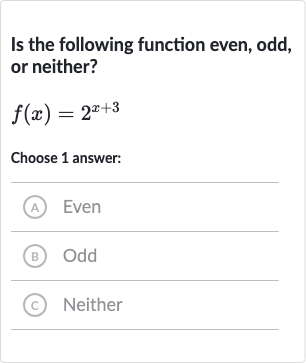Full solution
Q. Is the following function even, odd, or neither?Choose answer:(A) Even(B) Odd(C) Neither
- Symmetry properties of the function: To determine if the function is even, odd, or neither, we need to check the symmetry properties of the function. An even function satisfies for all in its domain, and an odd function satisfies for all in its domain.
- Checking if f(x) is even: Let's first check if f(x) is even. We need to compare f(x) with f(-x). We have f(x) = . Now let's find f(-x) which is f(-x) = .
- Comparing with : Now we compare with . If for all , then the function is even. We have and . These two expressions are not equal for all because the exponents are not the same due to the sign change in . Therefore, is not an even function.
- Conclusion: is not an even function: Next, let's check if is odd. For to be odd, we need to be equal to for all . We already have . Now let's find which is .
- Checking if is odd: We compare with . If for all , then the function is odd. We have and . These two expressions are not equal for all because the negative sign outside the exponent does not change the exponent itself. Therefore, is not an odd function.
- Comparing with : Since is neither even nor odd, the correct choice is (C) Neither.

